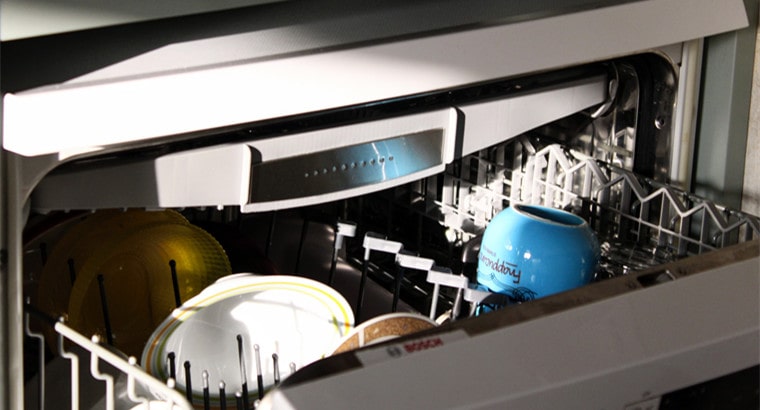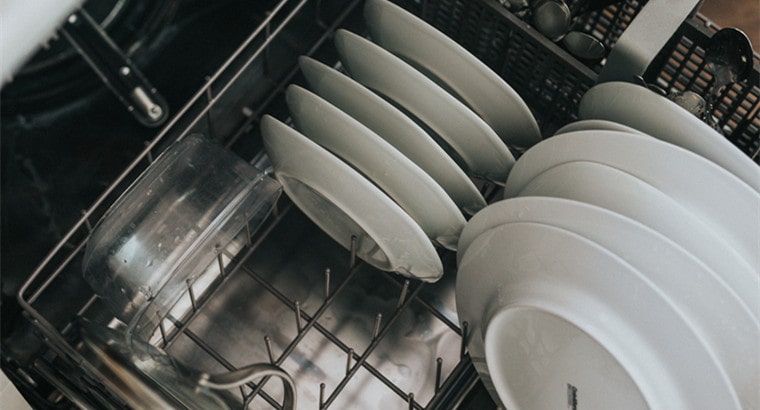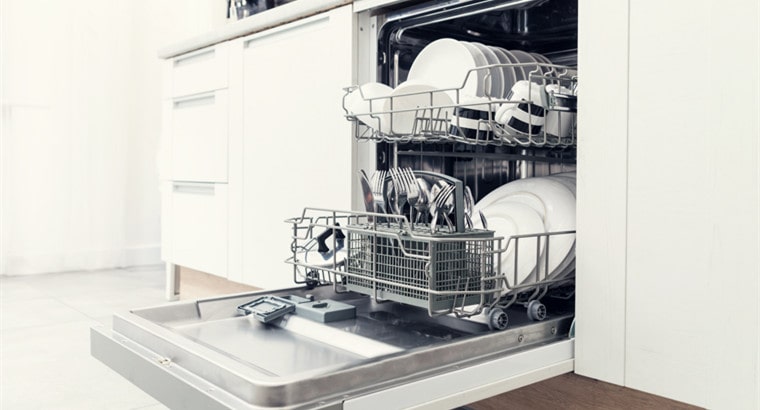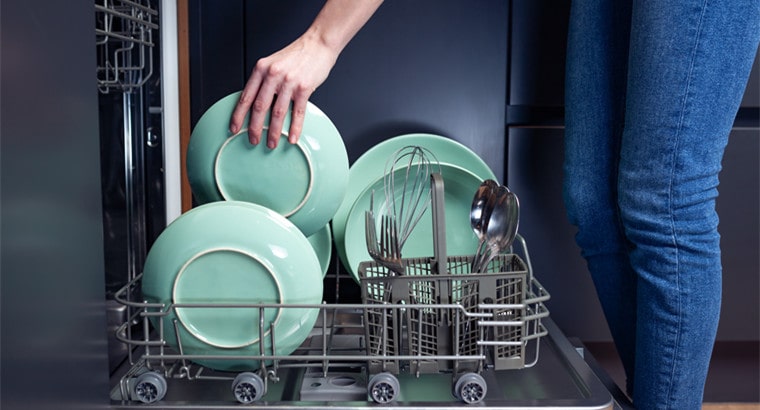Picture this — you just opened your dishwasher to unload a set of clean dishes. However, there is a huge puddle of water that sits at the bottom of your dishwasher, slowly gaining an unpleasant smell. Naturally, you’ll ask yourself — why is there standing water in my dishwasher?
While finding standing water in your appliance can be scary, it isn’t always a plumbing emergency. In fact, with a bit of help, you might be able to fix the problem yourself without having to call a professional. Ready to get your dishwasher working again? Then let’s dive right in — pun intended!
Why Is There Standing Water in My Dishwasher? 6 Causes

Generally speaking, there are many reasons why you can find standing water in your dishwasher. While some of them are cause for concern, you can fix others with a simple cleaning.
1. Drainage Hose Elevation Problems
The first troubleshooting step you should take is to check if the drain hose is properly elevated. Each dishwasher features one that is connected to the sink drain pipe or garbage disposal.
In order for water to drain properly and not flow back into the tub, the hose must have a supported loop that is elevated above the hoe’s connection point to the sink or garbage disposal. If the hose doesn’t have the proper elevation, your dishwasher will start to collect water.
2. Faulty Drain Pump
A dishwasher’s pump motor can fail mechanically or electrically. To check yours, you’ll need to use a multimeter and test for electrical continuity. If the motor tests negative, you’ll have to replace it entirely. Keep in mind that some dishwashers use the same motor for both draining and circulating the water.
3. Obstructed Drain Hose
Over time, the drain hose can get obstructed with food debris. Since the blockage can occur at any of the hose’s ends, you need to remove it entirely from the drain pump and the sink or garbage disposal pipe. Then, you’ll be able to inspect and clean any clogs that you might find.
4. Clogged Garbage Disposal
Sometimes, when connecting a drain hose to new garbage disposal, you might forget to remove the knock-out plugs. If that’s the case, water will be unable to drain properly, eventually blocking the hose.
Remember that you should literally knock out the plugs using a flat-head screwdriver and a hammer to apply enough force. However, if the plug has been removed properly, it might mean that the disposal is obstructed with food. So try to clean out its drain tube to remove all the clogs.
5. Malfunctioning Drain Solenoid Valve
Some types of dishwashers will have a solenoid valve whose job is to allow the water to drain. When the solenoid fails, it will prevent the valve from opening. Fortunately, you can use a multimeter to see if the solenoid tests negative for electrical continuity. If it does, you’ll have to replace the valve.
6. Defective Check Valve or Ball
Dishwashers rely on a check valve to stop water from returning once it has been pumped out. More often than not, the valve will get stuck in the closed position, trapping the water with no way to drain.
Usually, a simple cleaning will fix the issue, but if that doesn’t work, you’ll need to replace the valve. It’s important to note that some models feature a check ball, which you might have to replace if it constantly gets stuck in the valve.
Is It Safe to Run a Dishwasher With Standing Water in It?

Depending on how much standing water it has collected, your dishwasher could still run and finish its clean cycles as it should. However, most experts advise against using your appliance until the problem has been fixed. While running your dishwasher with standing water shouldn’t damage the appliance, it can cause health problems.
According to the CDC, standing water is a breeding ground for insects while also potentially attracting other pests. Additionally, it can promote the growth of mold and mildew in the dishwasher.
If not taken care of, the mold will spread throughout the house, causing serious damage to your property. So it’s best to get rid of any standing water before using your dishwasher again.
Drain Standing Water
Before you attempt to fix your dishwasher, you’ll need to carefully drain all the standing water. However, remember to always disconnect the dishwasher before cleaning or repairing it. Since it is most likely hardwired, you’ll need to turn it off using the circuit breaker.
When draining your dishwasher, you should first remove the lower dish rack. That will give you more space to work on the appliance. Then, you should soak up the standing water using a sponge and then squeeze it out into the sink. Alternatively, you can use a wet vac to suck up the water.
How to Fix It: 6 Ways

After draining the standing water, you’ll be able to use any of the following methods to fix your appliance. Keep in mind that if none of them are successful, you should contact a professional to have your dishwasher inspected.
1. Clean the Garbage Disposal
Many dishwashers don’t have their own dedicated plumbing line. In fact, they are connected to the garbage disposal, which itself is connected to the outdoor drain pipe. Without regular maintenance, food and debris will build up and prevent water from draining out of the dishwasher.
Usually, running some hot water and then turning on your disposal should get rid of the food matter. But sometimes, you’ll need to do some deep cleaning:
• Unplug your garbage disposal or turn off the circuit breaker that powers it.
• Use a flashlight to find any objects that need to be removed. Remember to use tongs and never put your hands in the disposal.
• If there is a significant buildup on the disposal’s blades, place a half-cup of rock salt and two cups of ice in the disposal.
• Restore power, let the water run, and turn on the disposal for a minute or two.
• Inspect the disposal using a flashlight to see if the blades are clean. If not, repeat the previous steps.
• You can also pour one cup of white vinegar followed by one-half cup of baking soda into the disposal, then let the solution sit for 15 minutes. As it fizzes, clean the inside of the disposal with an old toothbrush.
• Finally, restore power to the garbage disposal and test the dishwasher by running it without placing any dishes inside.
2. Clean the Drain Basket and Filter
The dishwasher’s drain basket and filter are supposed to catch food debris during a wash cycle. Therefore, they should prevent contaminated water from getting in contact with your dishes as they are being cleaned.
Unfortunately, over time, these parts will experience clogs from soap scum and food scraps, which will allow water to back up in your appliance.
You’ll be able to find the filter and basket at the bottom of the unit, but you can also use the owner’s manual to locate them. Please note that some models have one part that does the job of both, while others have separate filters and baskets.
After locating them, take a closer look and see if there is any food stuck inside. If there is, you’ll need to clear the blockage:
• First, cut power to your unit to ensure your safety.
• Remove the basket and filter using your owner’s manual as a guide.
• Empty the basket and use an old toothbrush and a mix of mild detergent and warm water to clean it.
• Before placing the basket back into the appliance, remove any soap residue by rinsing.
It’s important to mention that some dishwashers don’t have a removable basket. If that’s the case, you should clean the filter and remove any debris using needle-nose pliers or the hook of a wire hanger.
3. Straighten or Unclog the Drain Hose
As the name suggests, the drain hose removes water from your dishwasher. Over time, it will get clogged with food and suppress water flow. If that happens, the water will usually back up into your appliance. But there’s a fix:
• As always, turn off the power before working on your dishwasher.
• The hose has one end that is usually connected to the garbage disposal and the other to the pump on the back of your dishwasher. If you can’t locate it, check your owner’s manual.
• Make sure that the hose is not bent or folded. If there are no visible obstructions, you’ll need to check for clogs inside the hose.
• Place a small bowl under the connection points, so it can catch excess water while you disconnect the hose.
• Use a plumber’s snake or a hanger to remove any clogs. Similarly, you can use a garden hose to flush the drain hose and get rid of debris.
4. Unclog the Drain Pump
The dishwasher’s pump or drain tends to get clogged with food leftovers. To check if yours has a blockage, you’ll need to remove the filter and expose the pump and drain at the bottom of the appliance. While this method is a bit more complicated and requires hands-on work, it shouldn’t do any damage to your dishwasher.
• Disconnect the power to your appliance.
• Find the drain and drain pump using your owner’s manual.
• Use a plumber’s snake or a straightened wire hanger to get rid of any visible clogs.
• Mix half a cup of baking soda and one cup of white vinegar to remove leftover debris and gunk. Let the solution sit for 15 minutes, then pour hot water down the drain. Please avoid using chemical cleaners instead of vinegar as they can contaminate the dishes during future wash cycles.
• Next, find the drain pump and see if it has any blockages. Wear protective gloves if you need to reach inside, as it might contain glass or shell fragments. If you find any excess water in the drain pump, make sure to remove it using a sponge.
• After you’ve cleared all blockages, run a cycle without any dishes to see if the problem persists.
5. Unclog the Air Gap
Air gaps are small cylinders made from plastic or metal that are found near the sink. Although not every dishwasher model has one, air gaps can become clogged with food debris. When that happens, water won’t be able to drain properly and will eventually get back into the appliance.
Here’s how you can unclog it:
• Disconnect the power to the garbage disposal and dishwasher.
• Locate the air gap using the owner’s manual. Remove the casing and the diverter, which is a plastic cap that usually covers the air gap.
• Get rid of food debris by using needle-nose pliers or tweezers.
• Clean the inside of the air gap using a pipe brush and soapy, warm water.
• If you notice any clogs deeper inside the air gap, you might need to use a slim plumber’s snake to push them out to the garbage disposal area. That way, you will clear the entire pipe.
• Carefully reassemble the parts and run the garbage disposal. Then do a test run of your dishwasher without dishes to see if the problem persists.
6. Clean the Spray Arm
Spray arms are propellers that spray your dishes with water during a washing cycle. Hard water deposits and food can eventually block the holes in the arm, disrupting the water flow.
In some rare instances, blocked spray arms can cause water pooling in your dishwasher. As a matter of fact, most experts recommend cleaning the spray arms regularly, not only to avoid water pooling but to maximize the effectiveness of your dishwasher. That’s because when clogged, the arm won’t distribute water throughout the chamber properly.
When cleaning the spray arm, make sure to follow these instructions to prevent damaging your dishwasher:
• Cut power to the dishwasher.
• Find the spray arms and remove them, so you can check for clogs. You’ll usually locate them at the bottom or in the center of your unit. Remember to check your owner’s manual before disconnecting the spray arms.
• Use a thin wire or a toothpick to clean each individual hole.
• If the clog has hardened and can’t be removed, soak the spray arm in vinegar and warm water for at least 30 minutes. The mixture should soften the debris and make it much easier to clear.
• Install the spray arms and run a wash cycle to check if the problem has been fixed.










